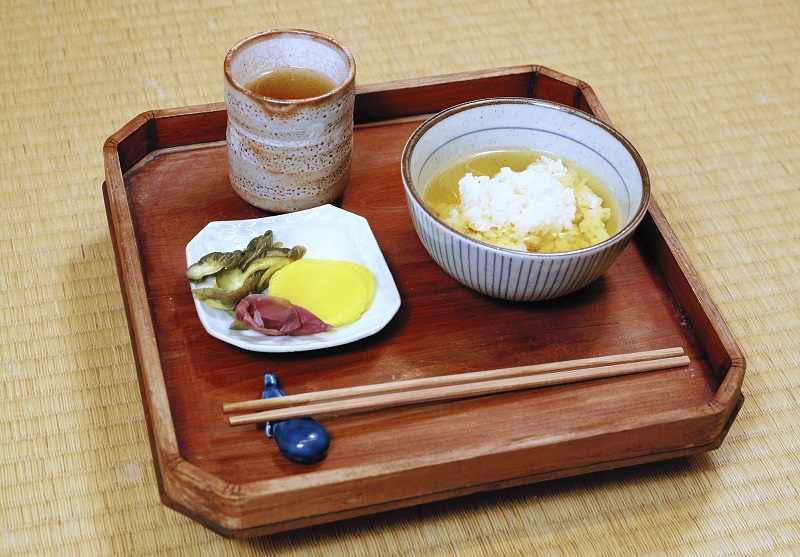Ueda Akinari, the Edo-period master of sencha tea culture who left his past behind several times over

The Yomiuri Shimbun Chazuke, right, a dish in which sencha green tea is poured over cold rice, is served with pickled vegetables. This was an everyday meal for common people during the Edo period.
18:41 JST, October 3, 2022
In Japan, drinking green tea gradually became an everyday activity in the 18th century, the middle of the Edo period (1603-1867). The idiom “nichijo-sahan” literally means to drink tea and eat rice every day, but is actually used to mean commonplace affairs.
Around that time, the Sugimoto family of renowned kimono dealers was founded in Kyoto. Among papers left by successive heads is the family’s policy on meals. It says, chazuke (or ochazuke) — a bowl of rice with green tea poured over it — and konomono pickled vegetables should be eaten in the morning and evening.
In other words, the family used to eat freshly cooked rice for lunch, and for breakfast and dinner, green tea was poured over the leftover cold rice and it was served with konomono.
The tea used for chazuke is sencha green tea, which has a smooth taste. Matcha is too rich for chazuke.
In 1952, two centuries later, Yasujiro Ozu directed the film “Ochazuke no Aji” (The Flavor of Green Tea over Rice). The title is reminiscent of ordinary but precious everyday life.
To return to the middle of the Edo period, one of the most prominent people of sencha tea culture was Ueda Akinari (1734-1809), who is also known as the author of “Ugetsu Monogatari” (Tales of Moonlight and Rain), a collection of nine supernatural tales. The book was adapted into a movie in 1953 by Kenji Mizoguchi, another leading film director in the postwar period.
Ueda also wrote “Seifu Sagen,” a commentary on sencha. In the book, he writes about the history and varieties of tea, tea-making methods, utensils and storing methods. They are accompanied by images of things like hearths and teapots. This book contributed to the increase in popularity of sencha.
Ueda moved from Osaka to Kyoto when he was 60, and formed a group of cultural figures in Kyoto who enjoyed drinking sencha. Leading scholars, poets and painters enjoyed sencha together while discussing literature and art.
In the tradition of French salon culture, the wives of aristocrats and high-ranking bourgeois invited cultural figures as well as people of the same class and taste to their grand houses. Meanwhile, all the houses lived in by Ueda, who moved nine times in the 16 years before his death in Kyoto, were small.
Ueda wrote that his first house was so small that you could not fit both knees together in the same space.
It was, of course, an exaggeration, but it must have been very difficult for him to invite people to his home. Ueda used to hold gatherings at the houses of his friends, which are believed to have mostly been modest in size, too.
Sencha tea culture was based on unconventionality. Baisao (1675-1763), who spread awareness of sencha throughout society and about whom I wrote in my previous column, also abandoned his status as a high priest and peddled tea in Kyoto.
Ueda was adopted by the reasonably wealthy owner of Shimaya, a paper and oil shop in Osaka. But Ueda left Shimaya after the shop caught fire and became a physician. He quit the practice after a girl died because he made a misdiagnosis.
After moving to Kyoto, Ueda published a collection of waka poems and prose, as well as “Harusame Monogatari” (Tales of Spring Rain), a collection of short stories that is still highly regarded today, and a series of books on Japanese classical literature.
Yet, Ueda left his past behind again. Having thrown five bundles of drafts into an old well at his home, he wrote, “My heart has cooled.” He must have felt relieved.
The well is said to be the one that is now found in the garden of Yachiyo, a restaurant and inn in front of Nanzenji temple in Kyoto. But no other traces of the home remain.

A photo taken in December 2016 shows a well at Yachiyo, a restaurant and inn in Sakyo Ward, Kyoto, into which Ueda Akinari is said to have thrown five bundles of his drafts.
"JN Specialities" POPULAR ARTICLE
JN ACCESS RANKING






